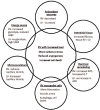Avalanches in cardiology
- PMID: 34667416
- PMCID: PMC8457267
- DOI: 10.4103/apc.apc_235_20
Avalanches in cardiology
Abstract
Sudden cardiac death (SCD) accounts for 15%-60% of mortality in patients with heart disease. Generally, this has been attributed to ventricular tachyarrhythmia. However, ventricular tachyarrhythmia has been documented or strongly suspected on clinical grounds in a relatively small proportion of SCD patients (8%-50%). Attempted prophylaxis of SCD by implantation of cardioverter-defibrillator is associated with variable success in different subsets of high-risk cardiac patients (30%-70%). A significant number of SCD, therefore, appear to be due to catastrophic circulatory failure. Multiple interdependent compensatory mechanisms help to maintain circulation in advanced cardiac disease. Rapid, unexpected, and massive breakdown of the compensated state can be precipitated by small and often imperceptible triggers. The initial critical but stable state followed by rapid circulatory failure and death has been considered to be analogous to snow avalanches. It is typically described in patients with left ventricular (LV) dysfunction (ischemic or nonischemic). It is now recognized that SCD can also happen in conditions where the right ventricle (RV) takes the brunt of the hemodynamic load. Advanced pulmonary arterial hypertension and operated patients of tetralogy of Fallot with pulmonary regurgitation are of particular interest to pediatric cardiologists. A large amount of data is available on LV changes and mechanics, while relatively little information is available on the mechanisms of RV adaptation to increased load and RV failure. Whether the triggers and the decompensatory processes are similar for the two ventricles is a moot point. This article highlights the currently available knowledge on the pathophysiology of SCD in RV overload states, with special reference to RV adaptive and decompensatory mechanisms, and therapeutic measures that can potentially interrupt the vicious downward course (cardiac avalanches).
Keywords: Circulatory collapse; nonarrhythmic death; sudden death.
Copyright: © 2021 Annals of Pediatric Cardiology.
Conflict of interest statement
There are no conflicts of interest.
Figures



References
-
- Demerouti EA, Manginas AN, Athanassopoulos GD, Karatasakis GT. Complications leading to sudden cardiac death in pulmonary arterial hypertension. Respir Care. 2013;58:1246–54. - PubMed
-
- Hoeper MM, Galié N, Murali S, Olschewski H, Rubenfire M, Robbins IM, et al. Outcome after cardiopulmonary resuscitation in patients with pulmonary arterial hypertension. Am J Respir Crit Care Med. 2002;165:341–4. - PubMed
LinkOut - more resources
Full Text Sources
